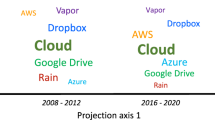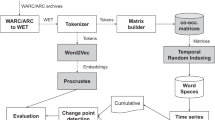Abstract
Historical, social and linguistic factors cause semantic changes that can narrow, broaden or completely alter the meanings of words. Frequency, syntactic and semantic variations are to be studied to examine such changes. Syntactic changes cannot be observed in many cases, if words have no POS variation. Context and connotation contribute more to semantic alteration. In addition, words have similar or related meanings in certain contexts, and the context is considered with diverse features such as co-occurrence and word association. The semantic change is generally related to the variation in n-gram context with a maximum of 5 g. However, distant context terms also play a prominent role in semantic change. There is also a link between the type of change and the use of lexical relations. This paper builds a knowledge-enhanced temporal word embedding model that utilizes ‘word-centric dependency relations’ for capturing context words irrespective of their n-gram position and ‘syntactic patterns for lexical relations’ for determining the type of semantic change. The joint learning of contexts with both dependency and lexical relations from diachronic corpora is performed to obtain temporal word embedding vectors. The proposed model outperforms other n-gram-based approaches when evaluated with standard diachronic corpora.











Similar content being viewed by others
Notes
References
Allen TT, Sui Z, Parker NL (2017) Timely decision analysis enabled by efficient social media modeling. Decis Anal 14(4):250–260
Allen TT, Sui Z, Akbari K (2018) Exploratory text data analysis for quality hypothesis generation. Qual Eng 30(4):701–712
Bansal M, Gimpel K, Livescu K (2014) Tailoring continuous word representations for dependency parsing. In: ACL (2) (pp. 809–815)
Berland M, Charniak E (1999) Finding parts in very large corpora. In: Proceedings of the 37th annual meeting of the Association for Computational Linguistics on Computational Linguistics. Association for Computational Linguistics, pp 57–64
Bian J, Gao B, Liu TY (2014) Knowledge-powered deep learning for word embedding. In: Joint European conference on machine learning and knowledge discovery in databases. Springer, Berlin, pp 132–148
Boukhaled M, Fagard B, Poibeau T (2019) Modelling the semantic change dynamics using diachronic word embedding
Church KW, Hanks P (1990) Word association norms, mutual information, and lexicography. Comput Linguist 16(1):22–29
Cook P, Stevenson S (2010) Automatically identifying changes in the semantic orientation of words. In: LREC
Cui H, Sun R, Li K, Kan MY, Chua TS (2005) Question answering passage retrieval using dependency relations. In: Proceedings of the 28th annual international ACM SIGIR conference on research and development in information retrieval. ACM, pp 400–407
Davies M (2014) Making Google Books n-grams useful for a wide range of research on language change. Int J Corpus Linguist 19(3):401–416
De Marneffe MC, Manning CD (2008) Stanford typed dependencies manual. Technical report, Stanford University, pp 338–345
Dubossarsky H, Tsvetkov Y, Dyer C, Grossman E (2015) A bottom up approach to category mapping and meaning change. In: NetWordS, pp 66–70
Gulordava K, Baroni M (2011) A distributional similarity approach to the detection of semantic change in the Google Books Ngram corpus. In: Proceedings of the GEMS 2011 workshop on geometrical models of natural language semantics. Association for Computational Linguistics, pp 67–71
Gupta S, MacLean DL, Heer J, Manning CD (2014) Induced lexico-syntactic patterns improve information extraction from online medical forums. J Am Med Inf Assoc 21(5):902–909
Hamilton WL, Leskovec J, Jurafsky D (2016a) Diachronic word embeddings reveal statistical laws of semantic change. arXiv preprint arXiv:1605.09096
Hamilton WL, Leskovec J, Jurafsky D (2016b) Cultural shift or linguistic drift? Comparing two computational measures of semantic change. In: Proceedings of the conference on empirical methods in natural language processing, vol 2016. NIH Public Access, p 2116
Hearst MA (1992) Automatic acquisition of hyponyms from large text corpora. In: Proceedings of the 14th conference on computational linguistics, vol 2. Association for Computational Linguistics, pp 539–545
Jatowt A, Duh K (2014) A framework for analyzing semantic change of words across time. In: Proceedings of the 14th ACM/IEEE-CS joint conference on digital libraries. IEEE Press, pp. 229–238
Kim Y, Chiu YI, Hanaki K, Hegde D, Petrov S (2014) Temporal analysis of language through neural language models. arXiv preprint arXiv:1405.3515
Komninos A, Manandhar S (2016) Dependency based embeddings for sentence classification tasks. In HLT-NAACL, pp 1490–1500
Kulkarni V, Al-Rfou R, Perozzi B, Skiena S (2015) Statistically significant detection of linguistic change. In: Proceedings of the 24th international conference on World Wide Web. International World Wide Web Conferences Steering Committee, pp 625–635
Kutuzov A, Ovrelid L, Szymanski T, Velldal E (2018) Diachronic word embeddings and semantic shifts: a survey. arXiv preprint arXiv:1806.03537
Levy O, Goldberg Y (2014) Dependency-based word embeddings. In: ACL (2), pp 302–308
Li Q, Li T, Chang B (2016) Learning word sense embeddings from word sense definitions. In: International conference on computer processing of oriental languages. Springer, Berlin, pp 224–235
Lieberman E, Michel JB, Jackson J, Tang T, Nowak MA (2007) Quantifying the evolutionary dynamics of language. Nature 449(7163):713
Lim S, Lee C, Ra D (2013) Dependency-based semantic role labeling using sequence labeling with a structural SVM. Pattern Recognit Lett 34(6):696–702
Lin D, Zhao S, Qin L, Zhou M (2003) Identifying synonyms among distributionally similar words. In: IJCAI, vol 3, pp 1492–1493
Maybaum R (2013) Language change as a social process: diffusion patterns of lexical innovations in Twitter. In: Annual Meeting of the Berkeley Linguistics Society, vol 39, no. 1, pp 152–166
Melamud O, McClosky D, Patwardhan S, Bansal M (2016) The role of context types and dimensionality in learning word embeddings (2016). arXiv preprint arXiv:1601.00893
Michel JB, Shen YK, Aiden AP, Veres A, Gray MK, Pickett JP, Pinker S (2011) Quantitative analysis of culture using millions of digitized books. Science 331(6014):176–182
Mitra S, Mitra R, Riedl M, Biemann C, Mukherjee A, Goyal P (2014) That’s sick dude!: automatic identification of word sense change across different timescales. arXiv preprint arXiv:1405.4392
Nastase V, Shirabad JS, Caropreso MF (2007) Using dependency relations for text classification. University of Ottawa SITE Technical Report TR-2007-12, 13
Niu L, Dai XY, Huang S, Chen J (2016) A unified framework for jointly learning distributed representations of word and attributes. In: Asian conference on machine learning, pp 143–156
Pelevina M, Arefyev N, Biemann C, Panchenko A (2017) Making sense of word embeddings. arXiv preprint arXiv:1708.03390
Phillips L, Shaffer K, Arendt D, Hodas N, Volkova S (2017) Intrinsic and extrinsic evaluation of spatiotemporal text representations in Twitter streams. In: Proceedings of the 2nd workshop on representation learning for NLP, pp 201–210
Ploux S, Boussidan A, Ji H (2010) The semantic atlas: an interactive model of lexical representation. In: Proceedings of the sixth conference of international language resources (ELRA), pp 1–5
Polajnar T, Clark S (2014) Improving distributional semantic vectors through context selection and normalisation. In: EACL, pp 230–238
Roller S, Erk K (2016) Relations such as hypernymy: identifying and exploiting hearst patterns in distributional vectors for lexical entailment. arXiv preprint arXiv:1605.05433
Sagi E, Kaufmann S, Clark B (2011) Tracing semantic change with latent semantic analysis. Curr Methods Hist Seman 73:161–183
Samha AK (2016) Aspect-based opinion mining using dependency relations. Int J Comput Sci Trends Technol 4(1):113–123
Schouten K, Baas F, Bus O, Osinga A, van de Ven N, van Loenhout S et al (2016) Aspect-based sentiment analysis using Lexico-semantic patterns. In: International conference on web information systems engineering. Springer, Berlin, pp 35–42
Schwartz R, Reichart R, Rappoport A (2015) Symmetric pattern based word embeddings for improved word similarity prediction. In: CoNLL, vol 2015, pp 258–267
Seitner J, Bizer C, Eckert K, Faralli S, Meusel R, Paulheim H, Ponzetto SP (2016) A large database of hypernymy relations extracted from the web. In: LREC
Stewart I, Arendt D, Bell E, Volkova S (2017) Measuring, predicting and visualizing short-term change in word representation and usage in social network. In: Eleventh international AAAI conference on web and social media
Sui Z (2019) Social media text data visualization modeling: a timely topic score technique. Am J Manag Sci Eng 4(3):49–55
Tang X (2018) A state-of-the-art of semantic change computation. Nat Lang Eng 24(5):649–676
Tang X, Qu W, Chen X (2016) Semantic change computation: a successive approach. World Wide Web 19(3):375–415
Tovar M, Pinto D, Montes A, González G, Vilarino D, Beltrán B (2014) Use of lexico-syntactic patterns for the evaluation of taxonomic relations. In: Mexican conference on pattern recognition. Springer, Cham, pp 331–340
Wijaya DT, Yeniterzi R (2011) Understanding semantic change of words over centuries. In: Proceedings of the 2011 international workshop on detecting and exploiting cultural diversity on the social web. ACM, pp 35–40
Yamaguchi K (2014) How do typological studies explain the semantic changes of english complex prepositions? Top Linguist 13(1):60–66
Zhao Y, Huang S, Dai X, Zhang J, Chen J (2014) Learning word embeddings from dependency relations. In: 2014 international conference on Asian language processing (IALP). IEEE, pp 123–127
Author information
Authors and Affiliations
Corresponding author
Ethics declarations
Conflict of interest
All authors declare that they have no conflict of interest.
Additional information
Communicated by V. Loia.
Publisher's Note
Springer Nature remains neutral with regard to jurisdictional claims in published maps and institutional affiliations.
Rights and permissions
About this article
Cite this article
Vijayarani, J., Geetha, T.V. Knowledge-enhanced temporal word embedding for diachronic semantic change estimation. Soft Comput 24, 12901–12918 (2020). https://doi.org/10.1007/s00500-020-04714-0
Published:
Issue Date:
DOI: https://doi.org/10.1007/s00500-020-04714-0




